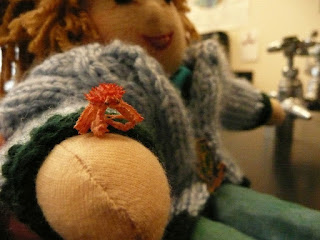Well, I'm still in Alaska but now I've been visiting Switgard Duesterloh in Kodiak.
It's been snowing so much here with temperatures of -10 °C - good thing Switgard sorted me out with a scarf and jacket, otherwise I would have frozen!
I have to admit, it hasn't just been all work and no play, I got to go cross-country skiing (my first time!) to check out the snowy landscape, frosted trees, frozen lakes, and I even saw some deer.
 |
| This is Switgard. |
 |
| At one stage I got so cold I jumped inside Switgard's jacket to stay warm! |
After an afternoon out skiing there’s nothing better than a cup of hot cocoa while huddled down under a blanket on the couch, so that's just what I did!
 |
| Yum! |
 |
| This is Dr Foy. |
 |
| Saying hi to a sea cucumber.
Next to the touch tank was a big, round aquarium with big fish and more sea stars, sea urchins and crabs.
|
 |
| Checking out an urchin. |
 |
| What a cool crab! |
I also got face to face with a hairy crab almost as big as me and you know what? ...The biggest sea stars in the world live here: Sunflower sea stars. There are some in the aquarium with over 30 arms and each arm is as long as my whole body!
After getting a feeling for the place, Switgard said that I was ready for the kids... so the next day it was time to join the students of Kodiak Middle School sixth grade in the Ocean Science Discovery Lab for a class introducing ocean acidification. First, Switgard talked about how people and animals breathe in oxygen (O2) and breathe out carbon dioxide (CO2), and the plants take up carbon dioxide and use the carbon for their growth and release the oxygen back into the air.
Then, they talked about how every time we burn something (wood, coal, oil, fuel), what you end up with, called the product, contains a lot of CO2. Over the last 200 years people have invented cars, buses, trucks, boats without sails, airplanes and lots of stuff, which all takes a lot of energy to make and run. Also, our houses and public buildings are heated with oil. All that has put more and more and more CO2 into the atmosphere; in fact, there is more CO2 in the layer around our planet now than there ever has been since there were humans!
Most of our planet is covered with ocean (about 75% of the surface of planet Earth is water) and over 30% of all that CO2 we have been producing has dissolved into the oceans. For a long time we thought that the ocean was helping us, but now researchers have found that CO2 dissolving into the ocean is changing the ocean chemistry - not good news!
Chemistry seems like a fancy subject for really brainy people, but Switgard makes it easy to understand by teaching the students how to build molecules (Which is what everything is made up of. Water is made up of water and hydrogen molecules!)
 |
| Making molecules with beads. |
The problem is, that the carbonic acid easily falls apart and then competes with all the shell-building animals for calcium in the water. (Calcium is what makes our bones hard and what animals with an outside skeleton use to build their shells).
 |
| Different things in the sea that are made up of calcium. |
 |
| A teeny tiny King Crab. |
After this explanation, Switgard got out a flask of seawater and some blue dye. She gave every group a beaker of the blue seawater and a pH meter. She explained how to use the pH meter and the students then measured the pH in their beaker of seawater.
 |
| Measuring the pH. |
Then, they used straws and blew bubbles into the seawater - how fun. Some boys made a mess!
After a while, the blue color disappeared, instead the water turned kind of yellowish. Another measurement with the pH meter showed that the pH was lower now. What had happened was that by blowing into the water they added CO2 to seawater and produced carbonic acid - just like ocean acidification!
So much informationin one day, but so much fun!
The next day, it was time for the grade 7's. They had a different project to do...they exposed young oysters to 3 different pH levels and then measured the effect on oyster growth.
 |
| I helped measure, |
 |
| and weigh oysters in the experiment and then... |
 |
| put it all onto the computer. |
Thanks to Switgard and all my new friends I made in Kodiak, I had soooooooooooo much fun! If you want to learn more, Sea Fans, why not visit the Kodiak lab and see for yourself what amazing work they do there...you may even get to see the teeny tiny crab I was holding. : )
Have a great week Sea Fans and a fantastic Christmas.
Chat soon.
Cheers
Abby
}( *)8


























